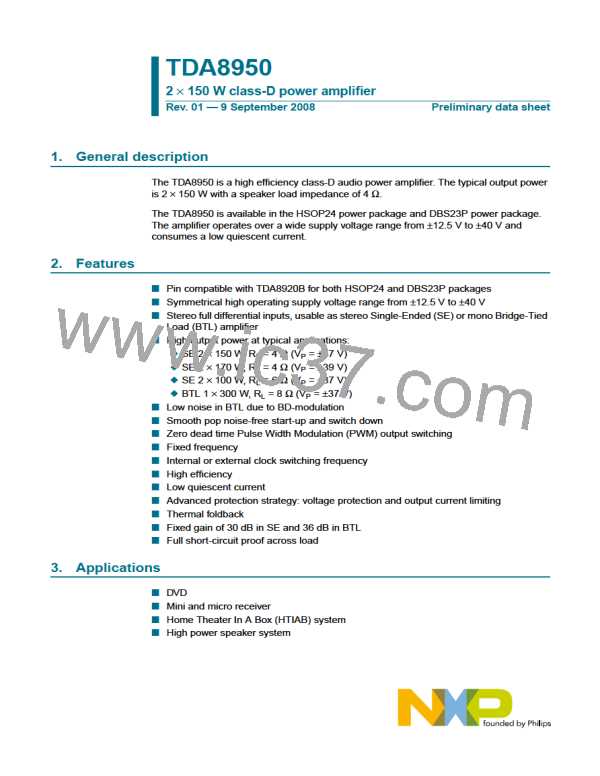TDA8950
NXP Semiconductors
2 × 150 W class-D power amplifier
The audio signal has a crest factor of 10 (the ratio between peak power and average
power (20 dB)), this means that the average output power is 1⁄10 of the peak power.
In this case, the peak RMS output power level would be the 0.5 % THD level, i.e. 220 W.
The average power would then be 1⁄10 × 220 W = 22 W.
The dissipated power at an output power of 22 W is approximately 5 W.
When the maximum expected ambient temperature is 85 °C, the total Rth(j-a) would then
(140 – 85)
become
= 11 K/W
-------------------------
5
Rth(j-a) = Rth(j-c) + Rth(c-h) + Rth(h-a)
Rth(j-c) = 1.1 K/W
Rth(c-h) = 0.5 K/W to 1 K/W (dependent on mounting)
So the thermal resistance between heatsink and ambient temperature is:
Rth(h-a) = 11 − (1.1 + 1) = 8.9 K/W
The de-rating curves (given for several values of Rth(j-a)) are illustrated in Figure 9. A
maximum junction temperature Tj = 150 °C is taken into account. From Figure 9 the
maximum allowable power dissipation for a given heatsink size can be derived or the
required heatsink size can be determined at a required dissipation level.
13.7 Output current limiting
To guarantee the robustness of the TDA8950, the maximum output current that can be
delivered by the output stage is limited. An advanced OverCurrent Protection (OCP) is
included for each output power switch.
When the current flowing through any of the power switches exceeds the defined internal
threshold current of 9.2 A (e.g. in case of a short-circuit to the supply lines or a
short-circuit across the load), the maximum output current of the amplifier will be
regulated to 9.2 A.
The TDA8950 amplifier can distinguish between a low-ohmic short-circuit condition and
other over current conditions like dynamic impedance drops of the loudspeakers used.
The impedance threshold (Zth) depends on the supply voltage used.
Depending on the impedance of the short-circuit, the amplifier will react as follows:
• Short-circuit impedance > Zth: The maximum output current of the amplifier is
regulated to 9.2 A, but the amplifier will not shut-down its PWM outputs. Effectively
this results in a clipping output signal across the load (behavior is very similar to
voltage clipping).
• Short-circuit impedance < Zth: The amplifier will limit the maximum output current to
9.2 A and at the same time the capacitor on pin PROT is discharged. When the
voltage across this capacitor drops below an internal threshold voltage, the amplifier
will shutdown completely and an internal timer will be started.
A typical value for the capacitor on pin PROT is 220 pF. After a fixed time of 100 ms the
amplifier is switched on again. If the requested output current is still too high, the amplifier
will switch-off again. Thus the amplifier will try to switch to the Operating mode every
TDA8950_1
© NXP B.V. 2008. All rights reserved.
Preliminary data sheet
Rev. 01 — 9 September 2008
20 of 39

 NXP [ NXP ]
NXP [ NXP ]